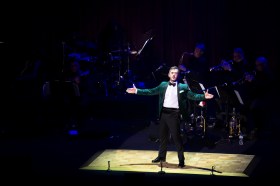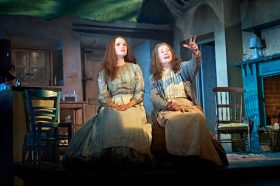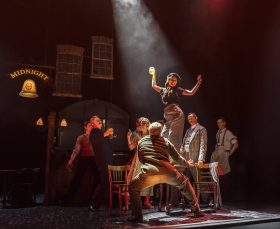John Howard’s conservative Australian government may be described by some as ‘The Abbott and Costello Show’, but it’s paying no tributes to the industry that launched the US comedy duo’s careers.
The Australian government recently revoked funding for the Australia New Zealand Climate Forum after delegates walked out on a show headed by burlesque performer Rebecca Gale, proving that the genre remains as provocative as it did in the days of Gypsy Rose Lee and Lili St. Cyr.
Once a mixture of comic plays and bawdy humour, burlesque reeled the crowds in by showcasing women in stages of undress that, over the years, grew progressively more revealing. By the 1920s, performers often ended their routines in nothing but a G-string and pasties; this precipitated a social crackdown in the US that contributed to the decline of the art form, which slowly gave way to the purely sexual striptease. When hard-core pornography arrived in the 1960s, it seemed to sound the final death knell for the art, but in recent years burlesque has proven its versatility by coming back into cabaret bars and concert venues around the world.
“In 1993, when I started performing burlesque, there were only a handful of other performers,” remembers Dita von Teese, a world-famous US burlesque artist renowned for her long, complex dances, and elaborate costumes and props. “Now there are countless acts and troupes, and beyond that, all of Hollywood is jumping on the bandwagon!”
Dubbed ‘New Burlesque’, the craze has sprouted up in such cities as New York, San Francisco, Vancouver and London. In Australia, troupes such as Hi-Ball, Man’s Ruin, Baby Take A Bow and Voodoo Trash Dolls adorn Melbourne’s burlesque scene, while Brisbane-based Lola The Vamp has performed in nightclubs and events around the globe, including the Edinburgh Fringe Festival. Sydney has its own Burlesque Festival, as do New York and Vancouver, and burlesque is so big in the US that it even has an annual burlesque convention, Tease-O-Rama.
While burlesque and the striptease are intimately connected, burlesque seems to be much more popular among women. Lily White, who performs regularly at The Whoopee Club, London’s premier burlesque nightspot, says that at least half the audience at most of the clubs she performs in are women, and most burlesque performers would agree that women find their performances much more palatable than they would a lap dance. “It’s a celebration of body types; there’s a joie de vivre feeling,” explains Bambi the Mermaid, who puts on the Burlesque at the Beach show on Coney Island in the US. “Most of the acts are funny. Girls see it and realise that they could get up there next week and do the same thing.”
“The use of an amazing prop, a gorgeous theme and aesthetic, beautiful choreography, clever ideas…these are the really interesting things about the burlesque of today,” explains Lola The Vamp, who is writing a PhD on the topic. Lola combines an imaginative selection of props with expensive costumes and jazz or classical music to construct her shows, which she has taken to audiences at the Mardi Gras and in Hollywood and Las Vegas. Among her many specialties is her wardrobe, which includes a tutu, a kimono and a vintage 20s pyjama set, hand-embroidered in Oriental style.
Lola’s famous contemporaries also sport a winning combination of costumes, dances, music and props. Von Teese’s famous martini glass act has brought her so much fame that her goth rocker husband Marilyn Manson recently revealed, “In Europe, some people call me Mr Dita von Teese!” She has also written a book called Burlesque and the Art of the Tease/Fetish and the Art of the Tease, which was published earlier this year. Her best friend, Catherine D’Lish, won the Exotic World Burlesque Museum‘s Miss Exotic World Pageant and boasts a collection of enormous props, including a gilded birdcage, giant spider web and eight-foot-tall waterfall, complete with fountains and flowers.
Contemporary burlesque groups are no less versatile. The LA-based Velvet Hammer Burlesque has an elaborate cast that includes belly dancers, tropical princesses, go-go gladiators, identical twin French maids and naked Amazons bound head-to-toe with rope. Their feature documentary, The Velvet Hammer Burlesque, was part of the 2004 San Francisco Lesbian and Gay Film Festival, and many of their cast members also appear in Broad Daylight, a feature film about modern-day burlesque stars set to a garage band soundtrack.
Some groups have an explicit theme running through their performances. The six Hi-Ball girls have a fetish for 1950s culture, which they indulge through a series of classic acts involving, among other things, fluffy fans, feather boas, fringe bikinis and flamenco dancing. Others, like The Belles of Shoreditch, who perform regularly at The Whoopee Club, are working strippers who see burlesque as an avenue through which to extend their repertoire. “The strip club mentality is I’m perfect, I’m ideal, I’m what you want and can never have in a girl,” says Bambi. “(With burlesque), I liked the idea that I was disturbing the guys in the audience more than trying to get ten dollars out of them.”
So what’s behind burlesque’s comeback? Perhaps the movement (or is that moves?) in part restores the sensuality of a Western culture increasingly desensitised to sex. Perhaps it’s a backlash against conservatism, especially in New York, where authorities have been clamping down on strip joints and banning smoking in public places. Or perhaps, as Clifton puts it, “People were just ready for that glamour and that different way of clubbing that’s not just putting on a DJ. That someone’s made an effort to make you want to come out.”
Whatever it is, it looks like burlesque is set to stay. At least it wants us to think so.




